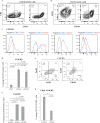Involvement of CX3CR1+ cells appearing in the abdominal cavity in the immunosuppressive environment immediately after gastric cancer surgery
- PMID: 38433196
- PMCID: PMC10910822
- DOI: 10.1186/s12957-024-03353-1
Involvement of CX3CR1+ cells appearing in the abdominal cavity in the immunosuppressive environment immediately after gastric cancer surgery
Abstract
Background: Gastric cancer is primarily treated by surgery; however, little is known about the changes in the intraperitoneal immune environment and the prognostic impact of surgery. Surgical stress and cancer-associated inflammation cause immune cells to mobilize into the abdominal cavity via numerous cytokines. One such cytokine, CX3CR1, has various immune-related functions that remain to be fully explained. We characterized the intraperitoneal immune environment by investigating CX3CR1+ cells in intraperitoneal lavage fluid during gastric cancer surgery.
Methods: Lavage fluid samples were obtained from a total of 41 patients who underwent gastrectomy. The relative expression of various genes was analyzed using quantitative real-time PCR. The association of each gene expression with clinicopathological features and surgical outcomes was examined. The fraction of CX3CR1+ cells was analyzed by flow cytometry. Cytokine profiles in lavage fluid samples were investigated using a cytometric beads array.
Results: CX3CR1high patients exhibited higher levels of perioperative inflammation in blood tests and more recurrences than CX3CR1low patients. CX3CR1high patients tended to exhibit higher pathological T and N stage than CX3CR1low patients. CX3CR1 was primarily expressed on myeloid-derived suppressor cells and tumor-associated macrophages. In particular, polymorphonuclear myeloid-derived suppressor cells were associated with perioperative inflammation, pathological N, and recurrences. These immunosuppressive cells were associated with a trend toward unfavorable prognosis. Moreover, CX3CR1 expression was correlated with programmed death-1 expression.
Conclusions: Our results suggest that CX3CR1+ cells are associated with an acute inflammatory response, tumor-promotion, and recurrence. CX3CR1 expression could be taken advantage of as a beneficial therapeutic target for improving immunosuppressive state in the future. In addition, analysis of intra-abdominal CX3CR1+ cells could be useful for characterizing the immune environment after gastric cancer surgery.
Keywords: CX3CR1; Fractalkine receptor; Gastric cancer; Intraperitoneal lavage fluid; Myeloid-derived suppressor cell; Programmed death 1; Tumor-associated macrophage.
© 2024. The Author(s).
Conflict of interest statement
The authors declare no competing interests.
Figures



Similar articles
-
Identifying a Novel Role for Fractalkine (CX3CL1) in Memory CD8+ T Cell Accumulation in the Omentum of Obesity-Associated Cancer Patients.Front Immunol. 2018 Aug 13;9:1867. doi: 10.3389/fimmu.2018.01867. eCollection 2018. Front Immunol. 2018. PMID: 30150990 Free PMC article.
-
CX3CR1 Acts as a Protective Biomarker in the Tumor Microenvironment of Colorectal Cancer.Front Immunol. 2022 Jan 24;12:758040. doi: 10.3389/fimmu.2021.758040. eCollection 2021. Front Immunol. 2022. PMID: 35140706 Free PMC article.
-
CX3CR1 deficiency exacerbates immune-mediated hepatitis by increasing NF-κB-mediated cytokine production in macrophage and T cell.Exp Biol Med (Maywood). 2023 Jan;248(2):117-129. doi: 10.1177/15353702221128573. Epub 2022 Nov 25. Exp Biol Med (Maywood). 2023. PMID: 36426712 Free PMC article.
-
Fractalkine/CX3CR1 is involved in the cross-talk between neuron and glia in neurological diseases.Brain Res Bull. 2019 Mar;146:12-21. doi: 10.1016/j.brainresbull.2018.11.017. Epub 2018 Nov 26. Brain Res Bull. 2019. PMID: 30496784 Review.
-
Structure and Function of Ligand CX3CL1 and its Receptor CX3CR1 in Cancer.Curr Med Chem. 2022;29(41):6228-6246. doi: 10.2174/0929867329666220629140540. Curr Med Chem. 2022. PMID: 35770395 Review.
Cited by
-
Novel immunotherapeutic approaches in gastric cancer.Precis Clin Med. 2024 Sep 19;7(4):pbae020. doi: 10.1093/pcmedi/pbae020. eCollection 2024 Dec. Precis Clin Med. 2024. PMID: 39397869 Free PMC article. Review.
-
Host-derived Interleukin 1α induces an immunosuppressive tumor microenvironment via regulating monocyte-to-macrophage differentiation.bioRxiv [Preprint]. 2024 May 5:2024.05.03.592354. doi: 10.1101/2024.05.03.592354. bioRxiv. 2024. PMID: 38746389 Free PMC article. Preprint.
-
G protein-coupled receptors: pivotal hubs in gastric cancer malignancy-from multidimensional crosstalk to precision therapeutics.J Transl Med. 2025 Aug 7;23(1):879. doi: 10.1186/s12967-025-06851-2. J Transl Med. 2025. PMID: 40775711 Free PMC article. Review.
References
-
- Yoshii M, Tanaka H, Ohira M, Muguruma K, Lee T, Sakurai K, Kubo N, Maeda K, Hirakawa K. Regulation of neutrophil infiltration into peritoneal cavity by laparoscopic gastrectomy. Hepatogastroenterology. 2015;62:546–550. - PubMed
-
- Imai T, Hieshima K, Haskell C, Baba M, Nagira M, Nishimura M, Kakizaki M, Takagi S, Nomiyama H, Schall TJ, Yoshie O. Identification and Molecular Characterization of Fractalkine Receptor CX<sub>3</sub>CR1, which Mediates Both Leukocyte Migration and Adhesion. Cell. 1997;91:521–530. doi: 10.1016/S0092-8674(00)80438-9. - DOI - PubMed
-
- Schmall A, Al-tamari HM, Herold S, Kampschulte M, Weigert A, Wietelmann A, Vipotnik N, Grimminger F, Seeger W, Pullamsetti SS, Savai R. Macrophage and Cancer Cell Cross-talk via CCR2 and CX3CR1 Is a Fundamental Mechanism Driving Lung Cancer. American Journal of Respiratory and Critical Care Medicine. 2014;191:437–447. doi: 10.1164/rccm.201406-1137OC. - DOI - PubMed
MeSH terms
Substances
LinkOut - more resources
Full Text Sources
Medical
Research Materials

